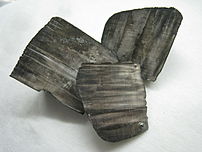Litio. Tabla Periódica de los Vídeos

El litio es un elemento químico de símbolo Li y número atómico 3. En la tabla periódica, se encuentra en el grupo 1, entre los elementos alcalinos. En su forma pura, es un metal blando, de color blanco plata, que se oxida rápidamente en aire o agua. Es el elemento sólido más ligero y se emplea especialmente en aleaciones conductoras del calor, en baterías eléctricas y, sus sales, en el tratamiento de ciertos tipos de depresión.
Es el metal más ligero, su densidad es la mitad de la del agua. Al igual que los demás metales alcalinos es univalente y muy reactivo, aunque menos que el sodio, por lo que no se encuentra libre en la naturaleza. Acercado a una llama la torna carmesí pero si la combustión es violenta la llama adquiere un color blanco brillante.
Wikipedia: Litio.
Lithium (pronounced /ˈlɪθiəm/) is a chemical element with the symbol Li and atomic number 3. It is a soft alkali metal with a silver-white color. Under standard conditions, it is the lightest metal and the least dense solid element. Like all alkali metals, lithium is highly reactive, corroding quickly in moist air to form a black tarnish. For this reason, lithium metal is typically stored under the cover of oil. When cut open, lithium exhibits a metallic lustre, but contact with oxygen quickly returns it back to a dull silvery grey color. Lithium is also highly flammable.
According to theory, lithium was one of the very few elements synthesized in the Big Bang, although its quantity has vastly decreased. The reasons for its disappearance and the processes by which new lithium is created continue to be important matters of study in astronomy. Lithium is tied with krypton as the 32nd or 33rd most abundant element in the cosmos (see Cosmochemical Periodic Table of the Elements in the Solar System), being less common than any element before Rubidium (element 37) except for scandium, gallium, arsenic, and bromine, yet more common than any element beyond krypton (element 36).
Due to its high reactivity it only appears naturally on Earth in the form of compounds. Lithium occurs in a number of pegmatitic minerals, but is also commonly obtained from brines and clays; on a commercial scale, lithium metal is isolated electrolytically from a mixture of lithium chloride and potassium chloride.
Trace amounts of lithium are present in the oceans and in some organisms, though the element serves no apparent biological function in humans. Nevertheless, the neurological effect of the lithium ion Li+ makes some lithium salts useful as a class of mood stabilizing drugs. Lithium and its compounds have several other commercial applications, including heat-resistant glass and ceramics, high strength-to-weight alloys used in aircraft, and lithium batteries. Lithium also has important links to nuclear physics: the splitting of lithium atoms was the first man-made form of a nuclear reaction, and lithium deuteride serves as the fusion fuel in staged thermonuclear weapons.
Wikipedia: Lithium.
Vídeo del grupo Evanescence
![Reblog this post [with Zemanta]](http://img.zemanta.com/reblog_e.png?x-id=c8e460a4-b32f-4f3d-8b39-2d0f7718eb95)










27 de diciembre de 2009 a las 12:26
mira, por favor no os lieis tanto decid cuales son los atomos mas importantes y porque.
Asi uno encuentra lo que busca rapido ademas que este muy bien.